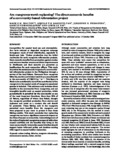Are mangroves worth replanting? The direct economic benefits of a community-based reforestation project

View/Open
Date
2006Author
Page views
339Metadata
Show full item recordCited times in Scopus
421 readers on Mendeley
2 readers on CiteULike
Share
Abstract
Competition for coastal land use and overexploitation have reduced or degraded mangrove coverage throughout much of their distribution, especially in South-east Asia. Timber production was the initial motivation for early mangrove reforestation projects. More recently, benefits from protection against erosion and extreme weather events and direct improvements in livelihoods and food security are perceived as justifications for such restoration efforts. This study examines the socioeconomic impacts of a community-led reforestation project in the Philippines through a survey of the local fishers. Revenues from mangrove fisheries, tourism and timber result in an annual benefit to the community of US$ 315 ha−1 yr−1. This figure is likely to be considerably more if the contribution of the mangrove to the coastal catch of mangrove-associated species is included. This estimate only includes direct benefits to the community from mangroves, and not intangible benefits such as coastal protection, which paradoxically is perceived by the community as one of the most important functions. More than 90% of all fishers, regardless of where they fished, thought the mangrove provided protection from storms and typhoons and acted as a nursery site and should be protected. Those fishing only in the mangrove perceived more benefits from the mangrove and were prepared to pay more to protect it than those fishing outside. This study concludes that replanting mangroves can have a significant economic impact on the lives of coastal communities. Acknowledgement of the value of replanted mangroves compared with other coastal activities and the benefits they bring to the more economically-vulnerable coastal dwellers should support better informed policy and decision-making with regard to coastal habitat restoration.
Suggested Citation
Walton, M. E. M., Samonte-Tan, G. P. B., Primavera, J., Edwards-Jones, G., & Le Vay, L. (2006). Are mangroves worth replanting? The direct economic benefits of a community-based reforestation project. Environmental Conservation , 33(4), 335-343. https://doi.org/10.1017/S0376892906003341
Subject
Collections
- AQD Journal Articles [1248]
